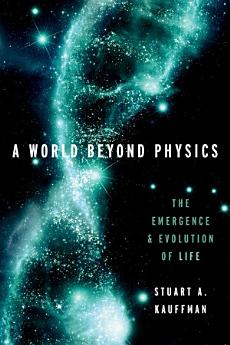A World Beyond Physics: The Emergence and Evolution of Life
Apr 2019 · Oxford University Press
4.0star
1 reviewreport
Ebook
320
Pages
family_home
Eligible
info
reportRatings and reviews aren’t verified Learn More
About this ebook
How did life start? Is the evolution of life describable by any physics-like laws? Stuart Kauffman's latest book offers an explanation-beyond what the laws of physics can explain-of the progression from a complex chemical environment to molecular reproduction, metabolism and to early protocells, and further evolution to what we recognize as life. Among the estimated one hundred billion solar systems in the known universe, evolving life is surely abundant. That evolution is a process of "becoming" in each case. Since Newton, we have turned to physics to assess reality. But physics alone cannot tell us where we came from, how we arrived, and why our world has evolved past the point of unicellular organisms to an extremely complex biosphere. Building on concepts from his work as a complex systems researcher at the Santa Fe Institute, Kauffman focuses in particular on the idea of cells constructing themselves and introduces concepts such as "constraint closure." Living systems are defined by the concept of "organization" which has not been focused on in enough in previous works. Cells are autopoetic systems that build themselves: they literally construct their own constraints on the release of energy into a few degrees of freedom that constitutes the very thermodynamic work by which they build their own self creating constraints. Living cells are "machines" that construct and assemble their own working parts. The emergence of such systems-the origin of life problem-was probably a spontaneous phase transition to self-reproduction in complex enough prebiotic systems. The resulting protocells were capable of Darwin's heritable variation, hence open-ended evolution by natural selection. Evolution propagates this burgeoning organization. Evolving living creatures, by existing, create new niches into which yet further new creatures can emerge. If life is abundant in the universe, this self-constructing, propagating, exploding diversity takes us beyond physics to biospheres everywhere.
Ratings and reviews
4.0
1 review
Brandon S-P
- Flag inappropriate
May 28, 2019
It was interesting and my first time reading a work from Kauffman. That being said the book contains relatively few new ideas that the author continually hammers upon. The phrase "non-ergodic universe above the level of the atoms" seems like it appears at least once every two pages. The book could have been cut in half and would have lost no real content. But it was a fun read for anyone interested in the dynamics of a evolving universe.
About the author
Stuart Kauffman is a medical doctor, theoretical biologist, and complex systems researcher. He has held professorships at the University of Chicago and University of Pennsylvania and was awarded a MacArthur Fellowship in evolutionary biology in 1987. He is the author of multiple seminal works including The Origins of Order (1993) At Home in the Universe (1996), Investigations (2002), and Humanity in a Creative Universe (2016).
Rate this ebook
Tell us what you think.
Reading information
Smartphones and tablets
Install the Google Play Books app for Android and iPad/iPhone. It syncs automatically with your account and allows you to read online or offline wherever you are.
Laptops and computers
You can listen to audiobooks purchased on Google Play using your computer's web browser.
eReaders and other devices
To read on e-ink devices like Kobo eReaders, you'll need to download a file and transfer it to your device. Follow the detailed Help Center instructions to transfer the files to supported eReaders.







